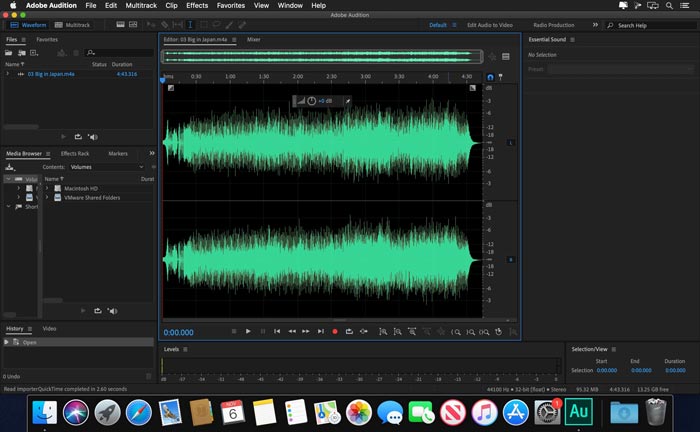Sending a sequence from Premiere Pro to Audition transfers the full fidelity of users' compositions. If a user wants to send their project to Audition for more advanced edits, all keyframes, effects, Essential Sound settings, markers, and metadata added in Premiere Pro are kept intact. Effects reference. Apply amplitude and compression effects to audio; Delay and echo effects; Diagnostics effects (Waveform Editor only) for Audition; Filter and equalizer effects; Modulation effects; Reduce noise and restore audio; Reverb effects; How to use special effects with Audition; Stereo imagery effects; Time and pitch manipulation effects.
Playing with Balance in Adobe Audition
Ever wanted to make it seem like footsteps are creeping up to your listener from one side and then “walking” past”? In Audition, it’s pretty easy to make something like that come to life.
Let’s start by opening a new multitrack session by going to File>New>Multitrack Session.
Our multitrack setup with three tracks inside of it.

This is actually really easy to do! All you have to do is grab the blue bar running horizontally and slide it up or down. Admittedly, this creates a problem because it would result in the ENTIRE track being balanced to whatever you moved it to. To fix this, we use what are called keyframes (Keep that name in the back of your mind, because it’ll come up in Premiere as well). You can see those in the picture below.
Basically, you want to listen to your track to determine when you want to change the balance, then create two keyframes. Why two? One is used to “hold” the balance (The one in yellow in the above image) and the other will actually move the balancer. This is important, because the audio will change after your “holder” keyframe, kind of like this:
Chupke chupke 1975 full movie download. Edited keyframes.
Notice how the audio moved (and faded rather than just jumping to one side; you can adjust that by sliding your second keyframe from left to right) only after the keyframe. That’s because the first frame just held the balance of everything before it so that it wouldn’t be affected. Akadanu naanga.
Eventually, you’ll probably want to re-center your audio. That’s not a problem at all in Audition! Just follow these steps in reverse, kind of like what I did above with my third and final keyframe.
So there you have it, a quick and simple way to modify your balance in Adobe Audition!
-Ryan Craig
This tutorial will show you how to import audio assets and use them in your podcast. We will also go over how to fade in and out and adjust audio levels of different clip segments.
If you are looking for supplementary audio files such as music and sound effects. Check out our Free Media Library. Here you can find additional audio assets that are free and at your disposal.
First, move all audio files you need in your project to the folder you created for your project. Your Auditon project will reference these files, so do not delete them after importing them.
Click File in the upper left of your screen.

Then hover your mouse over Import, and click File.
Select your audio assets. You can select as many as you want by holding Command (Mac) or Control (Windows) and clicking on each file you want.
Click open in the lower right corner of the window.
This will allow you to import audio files from your computer into your Audition project. You will want to import both music and sound effects this way for your podcast.
Your files will appear under Files panel on the top left of your screen.
To add music to your project, click on a music file and drag it into the music bed on your timeline.
Click and drag sound effects into the Sound FX track on your timeline.
Fade your Music and Sound FX
Audition Keyframe Effects Software
It is simple to fade in and out. Click and drag the little box icon on your music bed.
The fade will be indicated by a thin yellow line.
You can do this at the end of your music track as well to fade out.
Edit Volume Using Keyframes
Audition Keyframe Effects Download

Here we will create keyframes to either raise or lower the volume without affecting the whole track.
First, click on your audio track and make sure it is highlighted. Then hover over the yellow volume line that runs horizontally down the middle of your music track. Make sure not to be clicking on the white Pan line which is also in the middle of the track. When you click on the line it will create a control point.
Click along the line for multiple control points.
Manually drag the control points up or down to raise or lower the audio.
You can also edit the volume of the whole audio track in the name panel next to the track. Usually, music is too loud when used underneath a voice track.
Stellar phoenix patch. To edit the volume of the whole track just click-and-drag on the left circle in the name panel and drag up or down.
